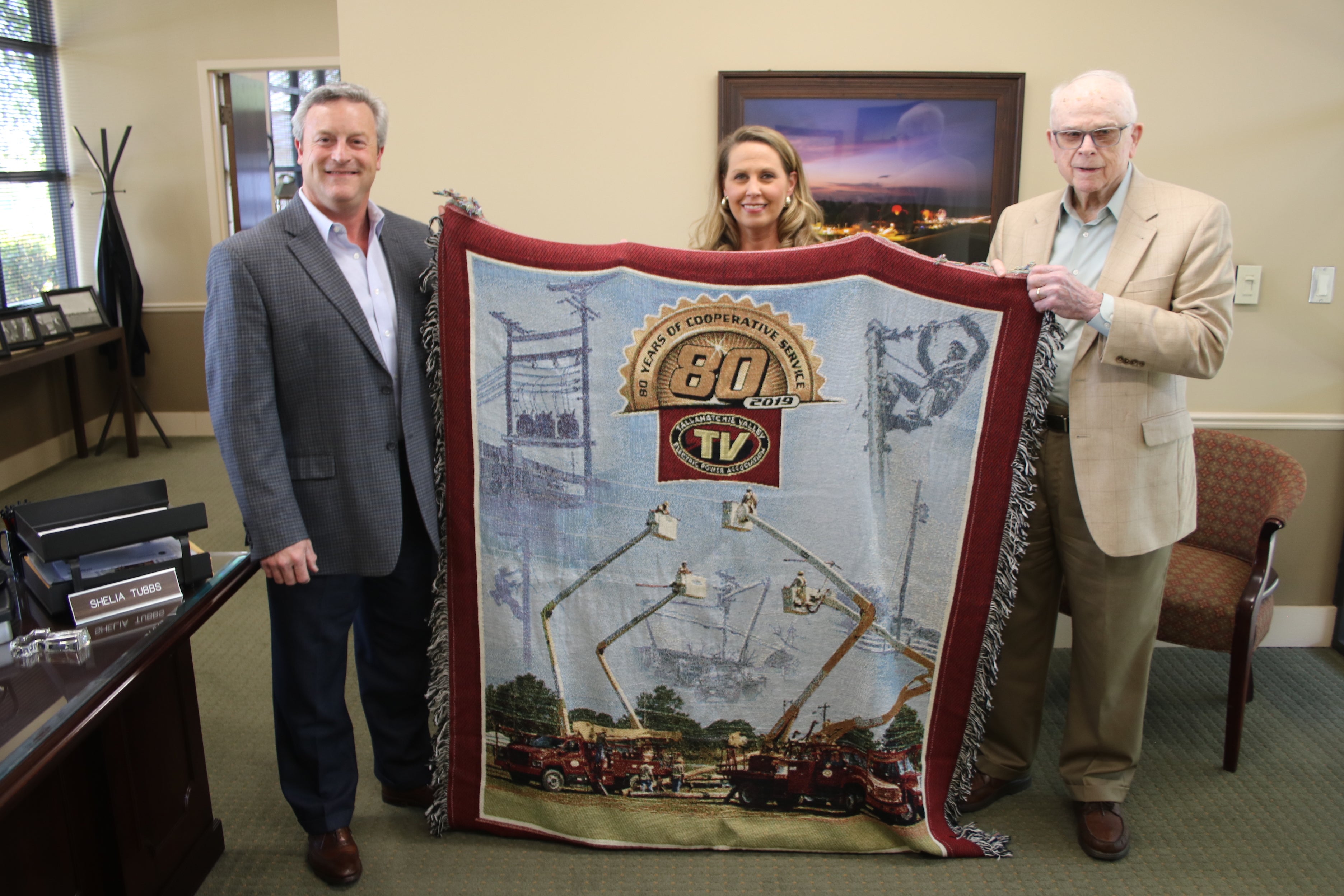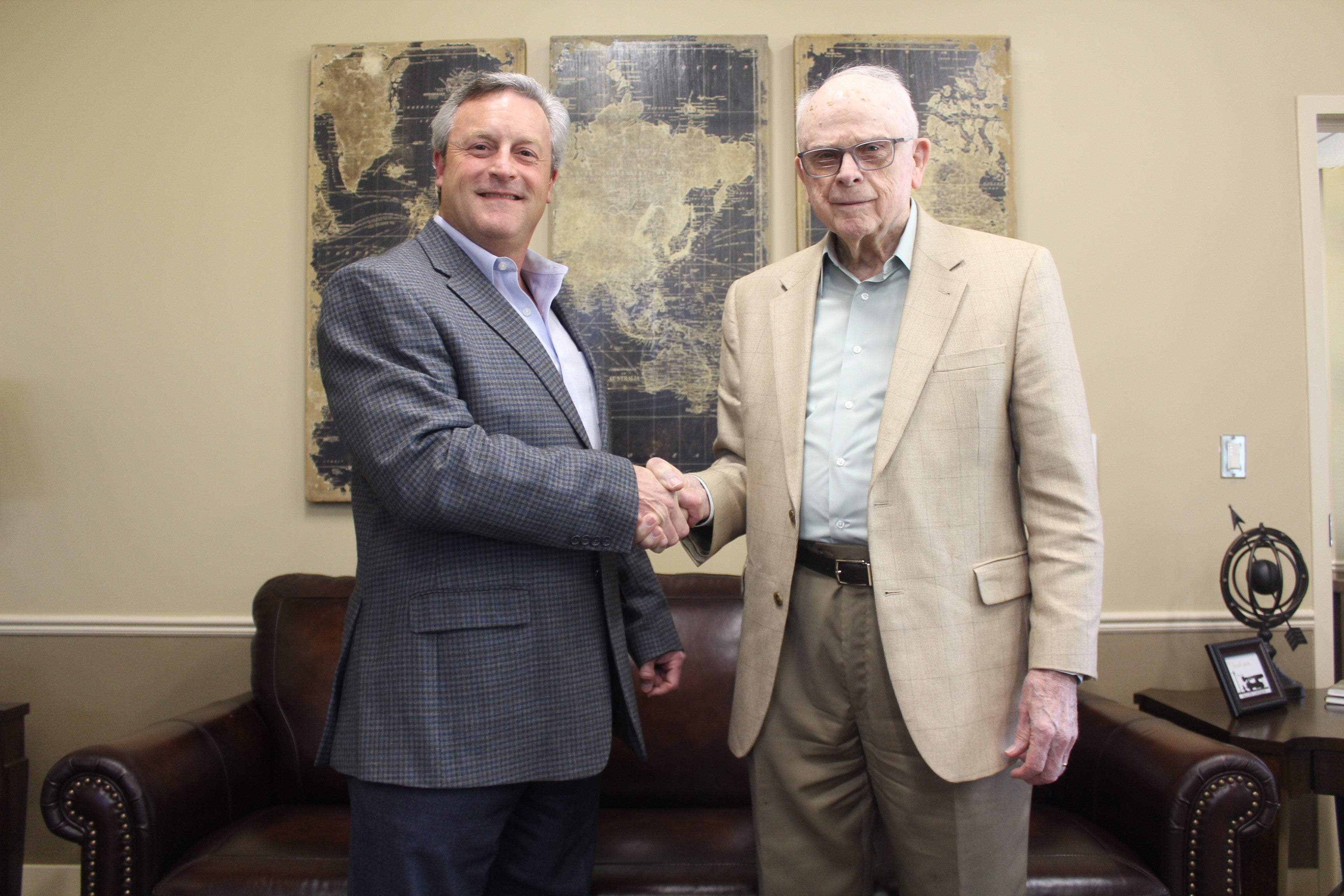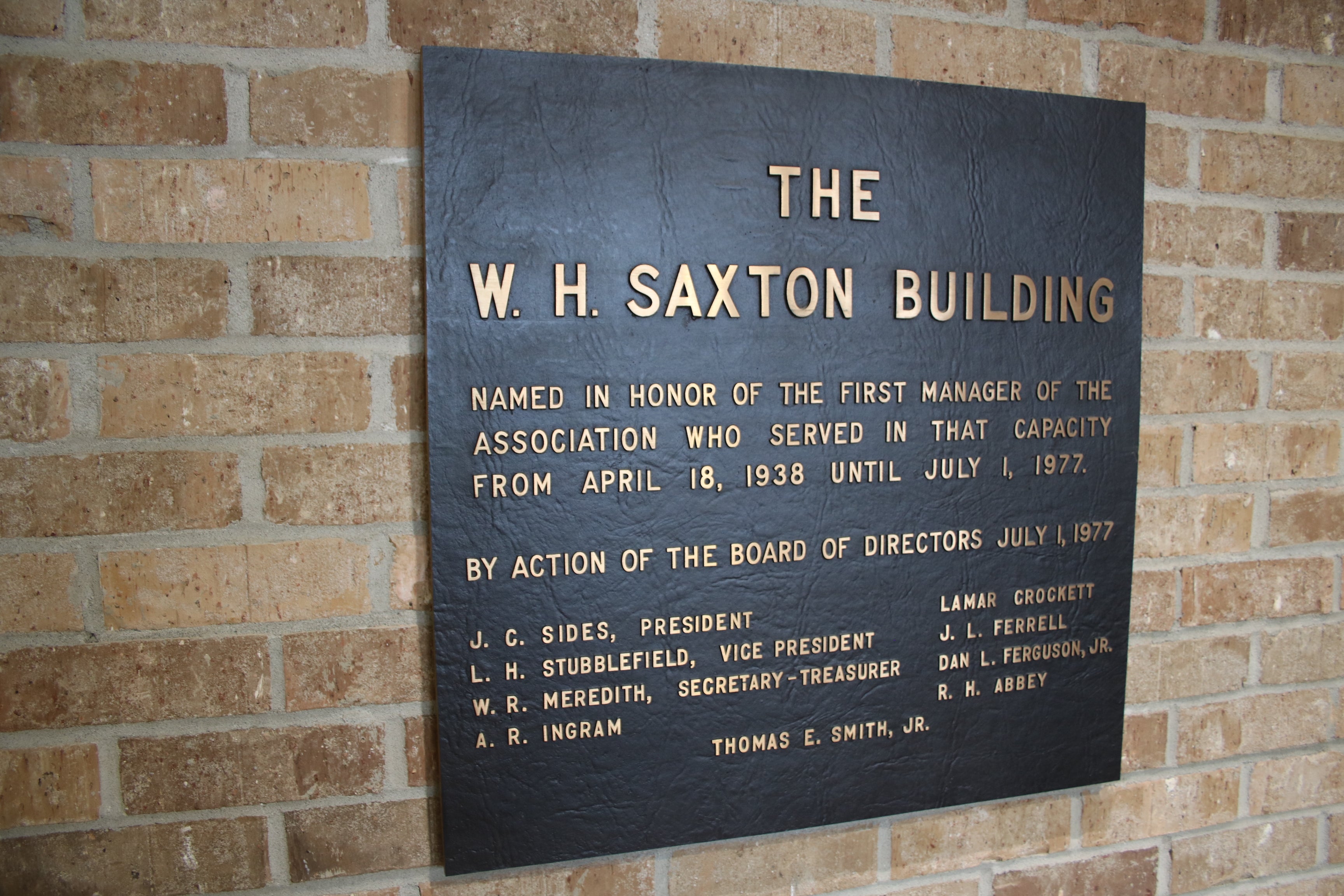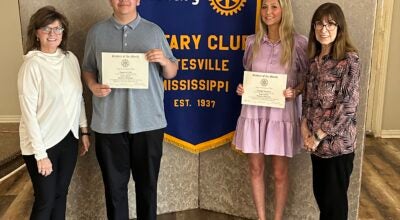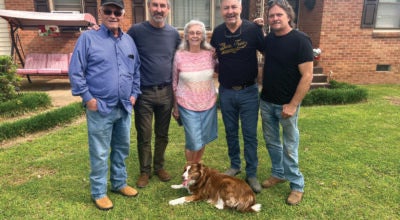Interview with George Randolph, former CEO at Tallahatchie Valley EPA
Published 3:59 pm Tuesday, March 24, 2020
Pictured is TVEPA CEO Brad Robison and the late George Randolph, who helped build TVEPA and was CEO for 20 years. The photo was taken April 22, 2019, on the 80th anniversary of the date the “lights came on” in rural Panola County.
The following is a transcription of a video interview with Mr. George Randolph taken a few years ago as part of a historical documentation of the beginnings of the rural electrification effort undertaken by the Tallahatchie Valley Electric Power Association. Special thanks to TVEPA executive secretary Sheila Tubbs for providing the transcript for publication.
Mr. Randolph passed away March 20, 2020, at age 94. We hope readers enjoy this interview and a look back on some of the happenings taking place in Batesville and Panola County as men such as Mr. Randolph worked to make the rural areas of Mississippi more progressive with modern utilities and new agricultural advancements.
Q: Will you take us back to the beginning of how you started with Tallahatchie Valley, why you took the job and how you got started here?
A: You want to go back that far?
Q: Yes sir.
A: Well, to give a little background on why I ended up here; I grew up in a home without electricity until I was about 13 years old and I knew what the change it made in our home to have an electric service and have the appliances and convenience it made possible. I had a I guess you’d say a weak or strong place, whichever, for electricity in the home. I was about 10 miles outside of Batesville.
As I started on through life, I won’t go into too much detail, I finished high school at Pope high school in 1942 and in December of 1941 of course is when Japan/Pearl Harbor, and I knew that I would probably need to face some service one way or the other with the military by the time I finished high school, which was April because we only had eight months of school back then.
I decided that since I was only 16 I decided to go ahead and get started in college even though I knew I’d have to serve in the military soon so I went to The Mississippi State University (laughter) back in those days it was Mississippi State College. It was the premiere school in the state so I began there in the fall of 1942 because I liked to farm. I especially liked fishing and hunting and the leisure time you had back in those days. In the type of farming that people did you had a few spare weeks in the summer time or a month or two for winter time for limited activity so I thought it was a good lifestyle. I could do things I was interested in at that time.
I enrolled in the fall in ‘42 and spring semester of ‘43. I knew I would be 18 in February 1944 so I joined the Navy in December of ‘43. They told me that they had designed, particularly for college students, (a program) that they allowed you to attend college another semester depending on how long you had already been in school and they would send you to the Navy Reserve school once you were at the stage they wanted you.
The neighbor who I roomed with grew up on the farm next to me and he got in the Navy program and I liked the idea that he was following so I was sworn into the US Navy Reserve in December 1943, and they called me to active duty in January 1944, a month before my 18th birthday and sent me down to Tulane.
That was one of the schools that they used along with about 50 others in the nation. I went to school there the whole calendar year of 1944 and of course they prescribed your courses to take. After that was completed they sent me to training at Princeton University and I stayed there about 3 months and transferred to Chicago to another school downtown at Northwestern Chicago.
I went through the Navy’s equivalent to the 90 day program and then was commissioned to an engine in the Navy Reserve July 1945. By that time the European Conflict was over and all of us boys, we were still boys at that time, even though we were staying in the girl’s dormitory at the time, there were no girls there. (laughter)
After I got my commission, all of us boys going through school at that time expected to spend the next 3-4 years in the Pacific winding down the war with Japan because the Japanese were very persistent on holding land they occupied. We all felt it was too long and drawn out and were afraid they would invade the mainland. We felt like we had a hard road ahead of us the next 2-4 years.
I was sent to the Navy Yard in Washington, DC, for training and, of course, in August 1945 Harry Truman authorized use of the atomic bomb which I always respect him for that. By the time that the second one was dropped in Japan, they saw the handwriting on the wall and pursued peace. I always feel like Harry Truman made the right decision even though a lot of civilians lost their lives because of it was a bigger saving in life because if we had not had to not use the bomb and we had to occupy more of the islands and the mainland we would have lost 200,000 to 400,000 people and they would have lost even more. I feel like it saved lives by using it.
Anyway, the Navy immediately changed their goals and commissioned officers and started laying up ships and decommissioning ships, put them in the what they call sleep, and they put me in that to dehydrate ships and prepare for long term anchorage, and then I was assigned to a shipyard there. The small aircraft carriers were designed to be used to escort ships that delivered supplies, so they were used by the Navy to prepare those ships for long term storage. (inaudible) “It get’s hard when you’re 87 years old, you forget”.
Anyway, the moth ball fleet is what they called it and I stayed out there for scaling, painting, guns, topside, etc. Then after I spent about 10 months out there I became eligible for separation. I had served long enough to be placed on inactive duty so I wanted to get back in school to finish my requirements and so I took up the opportunity to get on inactive duty. A lot of people transferred to the regular Navy on a permanent basis. I came through New Orleans , which is a good place for inactive duty.
In 1946 I went back to school at MS State in the fall semester and changed my major from general agriculture. I wanted a degree in that field. I had so many math and engineering classes at Tulane that I decided to go to Agricultural Engineering and use those resources I had toward a new degree in the fall of ‘46 and spring of ‘47, but no summer school, because the heat factor in 1944 at Tulane summer school was not pleasant.
I took a mechanical drafting course and I decided that in that heat I would not do summer school again. So, I returned to state that fall and it ended in January and graduated.
The manager of TVEPA had decided that the association needed an Ag Engineer because they had built a lot of lines. Of course, they built very little additional lines during the war because aluminum was scarce in construction so he wanted an AG Engineer to work with the consumer to educate them on the use of electricity in the home and on the farms to try to build up enough customers to generate money to pay off the loans from REA.
Mr. Saxton had a secretary that I had dated and she knew that I had graduated MS State in Ag Engineering. She did dictation and found out what he wanted the department head of MS State to recommend someone to work here so she told him that George Randolph just graduated. He wrote to me and my father inviting me to contact him.
The office at that time was where the City (Hall) is now, but the first office was located on the southeast part of the square. The building was owned by one of the Harmons but TVEPA rented it.
Q: When did they move into what is now the City of Batesville?
A: Now I can’t tell you exactly because it was during the war; I’m going to guess about 1942 or ‘43. There may be some old records or minutes of the board that will tell when they moved.
Q: I believe that when they financed with RUS Debt it may be around that time?
A: Yeah, of course back then it was REA, not RUS, but it was the same thing. It was built by local contractor Graves Brothers and lumber company and they built most of the buildings back in those days, 30-40s and 50s.
Q: Do you remember coming to talk to Mr. Saxton from school?
A: I think I came by and talked to him, but I can’t remember the specifics on the discussions. I believe I was on Christmas vacation at the time in 1947. He told me what he had in mind and what was in the process and anyway I didn’t make up my mind during the holidays, thought about it some.
The department head from college had heard from a job and insisted me on going to work for John Deere company because they hired a lot of the students and I could be a VP in the Deere company, so that was competition. But, at the same time, my time that I spent in New Orleans and Chicago while in the Navy, I didn’t want to be in a city and I still had the desire to have a life on a farm.
I turned things over in my mind with job offers and one was teaching Veterans in a program in the Veterans Administration to help them get readjusted, etc., so they had classes at some of the local schools, and infinite dealerships wanted me at that time. When I discussed it with my father he discouraged me from farming because he had been through the depression in the late 20s and 30s, which I grew up during the 30s, was born in 1926.
He, my grandfather, and uncle had a pretty large farm and he said you’re going to probably need to acquire more land and get set up with farming equipment, and costs so you will probably need a loan and economic outlook wasn’t good at the time as he thought there would be another depression, but we never did.
Anyway he suggested to go on and take a job and maybe after a few years you will be able to see what you can do towards getting started farming. That is what I did. I was glad I took his advice and settled down. I started in January of 1948.
Q: What did you do that first week or month, with your degree?
A: I tried to get acclimated with the job and how things worked, visited with managers, engineer departments. and discussed a lot of things. We had people from TVA that helped with the activities that I was going to be learning and carrying on, and so a few of them would come discuss possibilities with me.
The main thing that the association needed at that time was more lines constructed. More or less they had to stop building and constructing completely during the war so they were behind in getting electricity out. The manager wanted me to prepare maps for expansion, etc., to substantiate future loans and justify loans for financing the construction.
For four or five years, the biggest part of my time was surveying for lines to be built. By this time people had become accustomed to having electricity in their homes and on their farms. They knew what it meant to have it. So now they knew what it would be like to not have it and I very well recall going around with my father when he was trying to get others interested in getting service out to their area that there were some who had reasons that they didn’t need electric services.
I believe it was a few miles from where we lived, but we went to visit on a Sunday afternoon to discuss expansion and see if (a lady) wanted to sign an application for service. She spoke very slowly and said “Mr. Randolph, I know you’re right and you’re being nice, but I think there are more essential things that I need in my home that I need to get before I get electricity.” She had established priorities and electricity wasn’t high on her list of priorities.
Q: This was 1939?
A: This was 1937 or 38 before the association, it might have been after the certificate charter had been secured but it was before any construction had begun.
Q: You mentioned you were 13 when you got electricity so that was…
A: 1939, April 29th of 1939 I believe. That may be in some records somewhere.
Q: Nothing was energized until 1939. During construction it was not running electricity at that time. Was Highway 35 south one of the first energized?
A: That was one of the first. These things that we are talking about now in ‘35-37-38 the association began charter in ‘37 and hired Mr. Saxton as superintendent and they secured the first loan later that year, summer of ‘38, for the first loan and they started staking lines and this line that went out by the house I grew up in was not a highway, but a gravel road and we were fortunate to have that. \
That line when through Teasdale and Charleston, outside there and all the way to the Casilla area. There was another line that went to Eureka Community to Water Valley and Coffeeville.
I know other major lines at the time went through Pleasant Grove and up to Arkabutla. One from Batesville to Black Jack community. The engineers on the Sardis Dam had secured power from TVA at that time because they had a lot of power in the ‘30s. They did a survey out west to construct it on pumps onto the levee for the dam and TVA offered a low rate, but the engineers had to build a line over to Oxford.
All of my memories are subject to change if you find other proof. I can’t actually certify watts, etc. for the dam sight. They did all that in 1934. They had two 3,000 horsepower on a dredge boat that pumped the sand and silt to the levee. After TVA was organized of course the people involved in that organization were thinking about the source of power during that time and knew that had to be a factor in the operation. They could not get an answer out of TVA. The investor owned could survive REA, but the restricted clauses would prohibit smaller companies from building lines close to others, like Como, etc. around the highway.
They then started to get TVA to supply power to TVEPA at the Sardis Dam site so they thought they would tie into the lines which they eventually did. Someone could do some research and verify my memory of 60+ years ago. (laughter)
That’s where TVEPA received power from TVA from Sardis Dam on a three phase line running to Batesville. These other lines I mentioned before were two phase or three phase with one leg out. But this started a three phase line for 10 miles to Batesville, but it was one of the best moves that TVA ever made and it probably would never have been able to get service if that line had not already existed to Sardis Dam. It was restricted in the TVA act because it was an area they could serve.
And the political power in Washington with TVA was very much confined to a very limited area and they, TN Valley Authority, didn’t want to restrict them in language from Congress that they already had. So if that line didn’t provide that power to the dam already we probably would not have gotten power from them at that time.
Q: Talk about at that time the City of Batesville and TVA merger or how it came about
A: That’s interesting. I have been told a story about the MP&L providing service to Batesville by older people, but there’s nothing to confirm that I don’t guess. A man who was an electrical contractor here that worked a few years with me early on, relayed the information to me about Sardis and Batesville back in the 20s-30s. It may go back further like the time when Edison built it in New York in 1882 so it may be in the teens for down here.
Central Station generated power and was distributed to consumers and some experience came in the early 1900s so the investors and capital markets saw the possibilities of profits to be made. They began to finance a lot of smaller companies and what happened here is that MP&L (Mid South Utility) at the time it was a Delaware corporation; they bought the steam plant generator at lumber companies at Sardis and provided electricity right after WWI, 1918 or so, maybe 1920, and later built the line to Batesville. Then they built the lines to little towns together. They supplied all energy from the sawmill and steam turbine or generator from Sardis. They would operate it until about 11:30 or midnight because no one used it after that time anyway.
First thing the next day they would start it up for lighting as that was primarily the only early use at that time. My father worked and had some ownership with Irby Ford Dealership and they electrified their shop and used battery chargers, etc. but limited use. That’s how Batesville was supplied electric energy. After Tallahatchie Valley was organized the mayor, Mr. Ferguson, and some of the older citizens will remember Mr. Dan, from Union County, he knew about the TVA Power and Pontotoc and Tupelo were supplied by MS Power Company, subsidiary company of Common Wealth & Southern, Alabama Power, Georgia Power, Florida, Tennessee, etc. and taking the money back to New York.
When the TVA act was passed they were authorized to purchase utility in the TN area even though it was privately owned. That caused heated issues in Congress. But most towns had their own generators and used them; like Water Valley, Oxford, towns like that there were no questions about it.
They could cut them off and get it from TVA much cheaper, of course. Mr. Ferguson grew up in Union County and knew the advantage of TVA power so he was interested in getting that power to Batesville. It may have been in the 1930s when he started his term. He influenced some neighbors here, former Chancery Clerk, who owned land south of where I grew up so he supported it too. A lot of people took interest in TVA power from the very beginning. They knew starting Tallahatchie Valley would be necessary to get TVA power. Many trips to Washington were made to get it all worked out.
By the way, Mr. J.C. Sides was the first long term president and was originally a county agent in Yalobusha County and he influenced the house of representatives, a man by the name of Upchurch, to introduce a bill to the state legislature setting up MS Rural Electric Committee to help develop rural areas.
Mr. Sides was a progressive man that switched over to an FSA program and worked with agricultural things trying to conserve land and protect forest and species living there. He was the main instigator in getting it all completed with the agency with Tate, Yalobusha, Panola, etc. Each one of the local county groups of people started as soon as REA Act was passed in 1936. They began to lobby REA to finance in their area.
When REA engineers looked over everything they saw it would be much better to go together in a big company to band together. They held meetings in the courthouse that I did not attend but my dad did. They would try to get area counties to go in together. That’s what finally agreed to do after one of those meetings. At one time the paper ran some articles and I went back and read some of them back when I began working here. They selected a temporary board at that last meeting and secured a charter on December 31, 1937.
Q: How did they select Batesville over other areas as headquarters?
A: It was the central location. If you look at the service area map you will see it is pretty much in the middle and that was one of the reasons and of course the people from this area were the ones trying to influence the outside areas to be here. I think Charleston was in the running for headquarters, but they went with Batesville. I’m rambling too much.
Q: Oh, no sir. You came in with your AG Engineering degree; can you talk about that a little bit?
A: In the mid 50s, and later by the time the association had constructed most of the lines to rural areas, we tried to do it in a way to enable us to serve the greatest amount of consumers with the least amount of money invested as possible. Before I forget I would like to speak about one instance that happened here. Of course the first lines I mentioned, community centers like Eureka, etc., we tried to go to villages that would serve more consumers on a line rather than just one customer.
My father secured applications for service from many in Crowder and as a result that was one reason why the line was done out by my house was to get to Crowder and Teasdale, Tallahatchie County areas with more people. About six months before TVEPA got a line built to Crowder, MS Power and Light built a line coming in from Lambert to Crowder and started serving at the time, 7-8 merchants and population was about 200 people at the time. So it would be a nice little concentrated area for Tallahatchie Valley to serve.
People were so anxious to get service that even though they had signed for service with Tallahatchie Valley there was the other line so close that they wanted the service then and not have to wait a year before other lines were built. That existed for 2-3 years before we were able to take over those areas. At the time I understood, but I wasn’t working at that time, 1939-40 with Crowder, but REA had all these applications authorizing Tallahatchie to build lines in Crowder. MP&L had it where you had to hang your own transformers because they were a small operation. I remember when we had meetings with MP&L in later times, due to there always being conflicts on areas, REA was establishing everything and would see what they missed.
Mr. Saxton grew up in Yazoo City and the MP & L president did, too, so they knew each other and it made for some good battles. Tallahatchie Valley ended up serving Crowder and it was a good addition.
When TVA first went into operation they financed Alcorn County Electric Power Association being built and bought the City of Corinth and the idea was to serve small rural and municipalities would help support rural areas. Tallahatchie Valley, after Batesville, was still with MP&L. I’m not sure what year it took place but it was after I started working to it was in the 50’s or ‘49, but the City of Batesville was still being served by MP&L and Tallahatchie Valley couldn’t spend the funds from REA for Batesville, so they issued bonds, about $200,000 that they raised and built distribution systems.
Y’all might can find some of that information in Board Minutes. Tallahatchie Valley began operating in Batesville using TVA power at TVA rates. Naturally it was about half of what MP&L was at the time so most switched over as quickly as possible. But there were a few MP&L customers left and they were sold out to Tallahatchie Valley. That’s the way Batesville got TVA power. REA didn’t raise too much cane about it. (laughter)
Q: At that time the city got a board didn’t they?
A: Yeah, they did and I forgot …..Mr. Flint wasn’t the first from the town. Of course, it’s been a blessing for the town of Batesville to have TVA power and a lot of people in Sardis didn’t want it as bad as Batesville did. Anyway that’s basically how it came about.
Q: So when you started in 48 what was your title?
A: Utilization Engineer I think.
Q: How did you progress?
A: Later on, I think it stayed that. Now a lot of the REA co-ops hired people that they called power use advisors. That is similar to what I drifted into after we secured 100 percent area coverage. I devoted most of my time to more or less selling public relations and I did a lot of work with Vocational AG classes and 4H clubs, other organizations like that.
Some of the vocab teachers had adult students and farmers that they would meet with and asked me to help them with wiring and ways to help on the farms. And we tried to help with the home clubs and organizations, too, back in those days. All the counties had home demonstration agents, that would organize clubs for the ladies in the communities to advise them on how to feed their family and raise and can vegetables. We hired three or four home economists over the years that would go work with these other clubs to educate the ladies with electricity in the homes, safety, conserve on the costs, how to can foods in the summertime, etc. After food freezers were practical for home owners then we pushed how to conserve.
That reminds me on how I met my wife (laughs). I’ll expand my story to include that. One day I went down to Charleston to see the county agent as he had called me about a dairy farmer that wanted to put in a hay dryer. I went by the office as it was in the basement of the post office there and set up a date to meet the dairy farmer. But he wasn’t in. The home demonstration office was on the other side of the post office so I went in there to talk to her to see if she wanted me to meet with some of her clubs. McNeal was her name, I told her I had been to try to visit with him and that I thought I’d come visit with her. She said she’d like me to meet their assistant home demonstration agent, Nell Clement. So I found out all her qualifications (laughter again).
She had graduated from Delta State in 1950 and this was summer time and was working as an assistant agent for Tallahatchie County. I wasn’t expecting someone from Pearl County, but she had some other qualifications that might make for a good farm wife. I will always be indebted to my father for influencing me to take the job at Tallahatchie Valley because if not I would have never met her or any other county agent.
I deviate a bit, but I want to say that our creator, God, opens doors and he closes doors. Don’t get too discouraged when he closes a door because he has another one to open for you. That is the best way to go.
So anyway, I got more in to that PR work and education and as the association grew and people used more and more electrical energy on the farms and homes, more industries that we began to serve, and so forth then I started moving more into administrative work and they kind of designated me as administrative assistant. I started taking more of a hand in the overall aspect of things and things they would assign for me to handle, and I did that for 8-10 yrs and when we started getting close to retirement age, I began being an assistant manager.
Q: What year?
A:I don’t know, (laughter). Probably early 70s. He retired in 77 and I think I had been doing that for six years.
Q: We moved here in …
R: ‘74. We got a loan from REA in to construct the original building, it was approved in 1972. One of the last loans approved at interest rate at 2 percent. I am a conservative and member of the Republican Party. When some of the Republicans started in the 70s they had enough influence in congress to change REA’s interest rate, it wasn’t too low at the time, when they set that rate. The nation was borrowing at that rate, but after the war and 60-70s the rates started going up anyway.
Q: Did they not accuse us of moving out of town
A: Well some of the business people didn’t like to see the move because they felt like it would lessen the traffic on the Square and would lose some of the customers on the Square. There were a few that didn’t like the move. But we were moved by this time constructed the new place. We stored the poles on the back side of the lot up until we got that lot out on 35. I’m going to guess that was in the early 60s maybe late 50s because it was congesting the lot we were on in town.
I get to thinking about instances that happened along the path that we have trod to get to where Tallahatchie Valley is today. One thing is that it was a good building down there and Graves Bros. Lumber Company built it and they were known for great buildings and designs. It was built with good materials and an ideal location. Mr. Ferguson wanted to build a new City Hall so he didn’t want to buy that building. Mr. Sides and Mr. Saxton met with city people a few times to try to influence them to buy that building for City Hall and never could get it to work out with Mr. Ferguson. The vice mayor, or whomever, was in favor of buying the building along with several others. So Dan Ferguson went off to a mayor’s meeting for a few days. They called a city board meeting and during his absence they agreed on the contract to buy the building. When Mr. Ferguson got back in town he found out they had bought the building, good location and good building. I forgot what they paid, but it seems to me it was less than $50,000. I’d like to know what they did pay. Anyway, it was a good buy for the city.
After I had been administration assistant I became more interested in of course the overall operation and whereas in my first 10-15 years here I felt that we were doing a good job of helping to improve the living status of the people, particularly the ones in the rural areas. I guess you could say I felt it was my calling or mission here on earth to help with that accomplishment that we made back then. Of course after I got to dealing with the overall operation I could see where we could already serve everyone that needed service. Then my focus was to operate as economically as possible, hold the rates down as low as we could and hold operating costs down. All factors into providing electric services.
So you can say that became my general focus in the last 10-15 years that I worked here. We had a good service, reliable, as economically as possible.
Q: Mr. Randolph, you mentioned you felt that was your calling in life, you guess, and obviously the members appreciate that. To close this out can you take us through the end of your career? You made good relationships with workers, the community, and all around with people in other cooperatives.
A: Well, next to my wife, I would say that Tallahatchie Valley made my life, gave me the opportunity to serve people in a way that you could see results and certainly it didn’t make as much of my life as my wife did certainly, but it was certainly a big part of my life and built a lot of friendships all over our service area and in the state. People I worked with over the years, and I will just have to make a comment to Rural Electric People, most all that I associated with, out of a barrel of apples you may have one, but generally speaking, they were quote “Good People” and I think you’ll find most people in Mississippi and the Bible Belt that have opened up are, generally speaking, good people, raised in a Christian life with a corner person. Most people who grew up in the time that I did have it, but most rural electric people as a whole are good people and I believe that.
We have a lot of people who fought the Rural Electric battle, in the state and nationally, but while I am a conservative, and I believe in capitalism, when you talk about a utility operation that you can’t have a competitor down the street, consumers don’t have a choice, they either get it from you or don’t have service. It’s up to you to provide that service as best you can. It’s an obligation that a lot of businesses don’t have because they have competition. If I can’t get this service from Joe Blow then I’ll go over there to get it. The operation by nature has almost got to be a monopoly so you have an obligation that competitive businesses don’t have. I don’t know if I have told too many stories (laughter), branched off too much, but I’ve enjoyed visiting with y’all.


